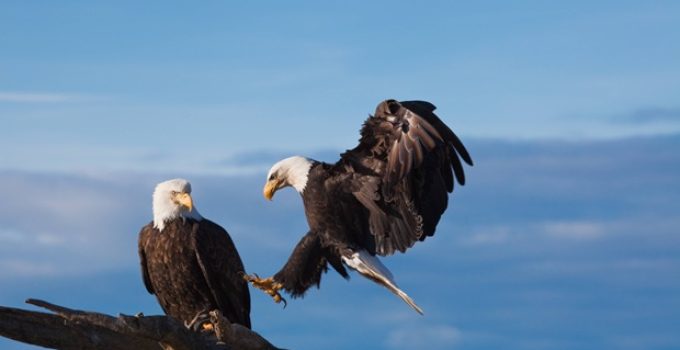Do Eagles Mate for Life?
Yes, many eagle species do mate for life—but with a few exceptions. Eagles, especially iconic species like the bald eagle, are known for forming long-term monogamous pairs that return to the same nest year after year. However, “for life” often means “for as long as both partners survive and breed successfully.”
Dive Deeper
- What Does It Mean to Mate for Life?
- Do All Eagles Form Monogamous Bonds?
- How Do Eagles Choose a Mate?
- What Happens If One Eagle Dies?
- Eagle Mating Behavior: A Quick Comparison
- 🎯 Final Thoughts
- 📚 References
💍 What Does It Mean to Mate for Life?
When scientists say eagles “mate for life,” they typically refer to seasonal monogamy maintained over multiple years. Once a pair bond forms, the eagles:
- Reunite at the same nesting territory annually
- Share nest-building and chick-rearing duties
- Perform bonding displays like cartwheeling flight
| ❤️ Statistic: According to the U.S. Fish & Wildlife Service, bald eagle pairs can remain together for 20 years or more, provided both partners survive and continue to reproduce successfully [1].
🧬 Do All Eagles Form Monogamous Bonds?
Most large raptors, including many eagle species, are socially monogamous, meaning they maintain a pair bond for reproduction and parenting. However, the extent of lifetime loyalty depends on the species and environmental factors.
| Eagle Species | Mating Behavior |
|---|---|
| Bald eagle (Haliaeetus leucocephalus) | Long-term monogamy common |
| Golden eagle (Aquila chrysaetos) | Typically monogamous |
| African fish eagle (Haliaeetus vocifer) | Monogamous; same nest reused annually |
| Harpy eagle (Harpia harpyja) | Monogamous with long parental care |
| 🧠 Note: Even in species that are monogamous, infidelity (extra-pair copulation) has been documented, though it is relatively rare [2].
🪶 How Do Eagles Choose a Mate?
Eagle courtship involves elaborate displays that help strengthen pair bonds and determine compatibility:
- Sky-dancing: Soaring together and locking talons mid-air
- Vocalizations: Species-specific calls exchanged at close range
- Nest presentation: Building or enhancing a nest site together
Young eagles reach maturity at 4–6 years old, and finding a lifelong mate is an instinctive and competitive process.
| 📊 Interesting Insight: Bald eagles often return to the area where they were born to find a mate and establish a territory [3].
☠️ What Happens If One Eagle Dies?
If one member of the pair dies or fails to return, the surviving eagle will:
- Remain near the nesting site, often waiting for a season
- Eventually seek a new mate to reclaim or rebuild the territory
- Resume breeding if a suitable partner arrives
While their loyalty is notable, eagles are also practical—ensuring reproductive success outweighs permanent mourning.
| ⚠️ Statistic: Eagle mortality rates vary, but adult bald eagles face threats like lead poisoning, collisions, and electrocution—prompting occasional mate replacement [4].
📋 Eagle Mating Behavior: A Quick Comparison
| Aspect | Eagles | Other Birds |
|---|---|---|
| Mate for life? | Often (bald, golden, harpy eagles) | Some do (swans, albatrosses); many don’t |
| Nesting site fidelity | High—same site reused annually | Varies—some migrate and nest in new areas |
| Parental involvement | Both sexes incubate and feed chicks | Varies—some birds offer no paternal care |
| Divorce rate | Low; usually only after failed breeding | Higher in species with low reproductive success |
🎯 Final Thoughts
So, do eagles mate for life? In many cases, yes. Eagles exemplify loyalty in the avian world, forming enduring pair bonds and returning to the same nesting territories year after year. Their partnership extends beyond reproduction—into shared labor, coordinated care of chicks, and remarkable aerial displays. Yet, their commitment is grounded in biological practicality: survival and successful breeding take precedence. Understanding eagle mating behavior helps us appreciate not just their loyalty, but the evolutionary strategies behind it.
📚 References
- U.S. Fish & Wildlife Service. (2021). “Bald Eagle Natural History.” https://www.fws.gov/species/bald-eagle-haliaeetus-leucocephalus
- Buehler, D. A. (2000). Bald Eagle Ecology and Management. Stackpole Books.
- Gerrard, J. M., & Bortolotti, G. R. (1988). The Bald Eagle: Haunts and Habits of a Wilderness Monarch. Smithsonian Institution Press.
- Harmata, A. R., & Restani, M. (1995). “Environmental contaminants and mortality in raptors.” Journal of Raptor Research, 29(3), 135–139.
